Golf Swing Made Easy
Today's subject is a good one: the golf swing made simple. I want to give you some thoughts that I think will really help you with your golf swing. To learn more after this article, check out some more great golfing lessons from George at http://tinyurl.com/george-gankas.
The golf swing made simple. I'm gonna show you two factors: straight hit and solid hit. I will also give you drills for each of those things that I think you'll find really, really simple. These might be great playing thoughts for you out while you're on the golf course. I hope these drills will make your swing really improve.
Okay, so let's take a look at how to make a golf swing simple. What are the two things that you have to be able to do to be good golfer? You have to be able to hit the ball solidly: you have to create some distance on the course. And the other thing you have to do is control your direction of ball reasonably well. So we're going to look at the first of the two keys. We're gonna give you one simple take-away to try and make this swing simple in each category. Don't worry if you're a novice golfer, these tips are perfect for everyone to stay fresh.
Let's first look a little bit at the direction. Let's assume for this this segment of the blog that you have a decent grip and a decent set up. We're not going to get exhausted into every element, that's important.
One of the keys to hitting the ball fairly straight, maybe the biggest key, is getting on a decent plane with the golf club. If your plane matches the design of of the club well- it doesn't come diagonally from in front of behind you, you're going to hit the ball reasonably straight. Now certainly you've got to hit it solidly. Certainly you have to have some clubface control at the bottom, that's very, very important. But I find that most people, if they have a decent grip on the club and they're on a decent swing plane, with a little bit of practice they get pretty good directional control in terms of these other variables. Let's have a look.
What's a simple key? And I'm going to go to the simplest. Listen, swing plane, some people make this out to be some super complicated problem and, 'a life's work' to get it right. It is simply not that difficult. One of my mentors, Fred Shoemaker, has this wonderful drill he teaches people that I think is a winner. I want to share it with you here. That is what he calls 'mapping out the right hand'. For the right-handed golfer that's your trailing hand. You can kind of correspond if you're a left-handed golfer playing right-hand you can find a figure out how to make this work for you as well.
Here is to do: stand with your feet planted as though you're about to swing a club. Then practice pivoting the trunk of your body (your upper body) as if you're about to swing a club. Get a golf ball if you can, if you don't have one of the house just pretend you have one in your hand. Then think to yourself, what if I had to take this golf ball and throw it like you're skipping a rock? How would you pull your arm up behind you before you skipped the rock? Would you bring your arm directly above your head, or would you bring it behind back and get ready to throw it from underneath/to the side of your body? The answer is to the side of and behind your body. If you practice this motion it is very instinctive for most people to know where they would put their hand. This is how you get this same motion to where you can use it in golf.
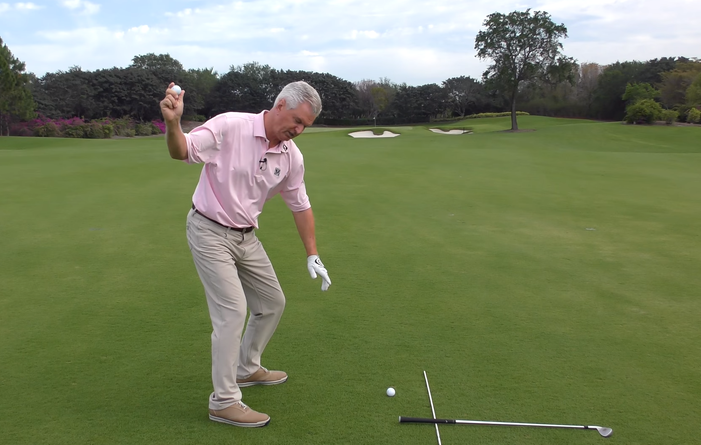
Make your pivot and find that spot with your arm where you think it's perfect for throwing the ball (skipping the rock). Now lean back with your throwing hand, and bring your front hand back to your back (rock throwing) hand while keeping your arm straight. That, is essentially how you will be holding the club up in year. Believe me it is easy to do. The brain works so well with his little mapping positions. It works much better doing stuff like that then a formula of turn, and do this, and do all that, and etc.
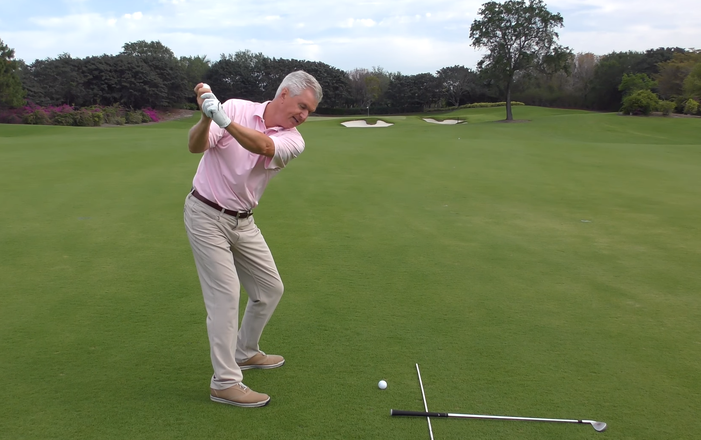
So try pivoting to put your hand in the spot, reach with your front hand, connect with your hand, and that becomes your spot with where you should be swinging from. Once you familiarize yourself with this then blend the motions together where you can reach and move both your hands together. Once you get familiar with your own body you will know where your hands end up.
After enough practice you will find that this exercise is very brain friendly and easy to do. Now, this may not make you a Justin Rose or a professional golfer on the PGA Tour but believe me it will get you in the neighborhood of good playing. Gary Player, a great player and one of my personal favorites (possibly one of yours too), used to talk about this. He had an old saying of 'taking the car (which is the right hand) and putting it in the garage (the top of his backswing).
Now, one of the little thing you that you might find interesting is that the brain is wired so that when you do something instinctive and simple like this drill: you will never see someone roll the club or do something unnecessary in their motion. It will always have a look of efficiency. It always goes right into the perfect spot at the top of your backswing. That's something you always want, consistency and quality.
Let's move on and talk about 'solid hit' when the ball on the ground (that's when there's no tee underneath it). That's what gives people the most problems. There's two things you have to do to get a pretty solid hit. These, you have to understand, are very, very simple. The first is: during your swing, when you are at impact, both your hips and the handle of the club shaft have to be more forward at impact then they were at address. Super simple.
I'll show you some examples from famous golfers and then give you a couple of quick drills so you can easily do this.
So here you can see my boyhood idol, Jack Nicklaus. Have a look at his hips there as he takes his address along with the line on his club shaft. If you look at that photo compared to when he is at impact you can see he is quite a lot more forward. Both his hips and his hands are much more forward than at address his head, as you can see, is pretty still.
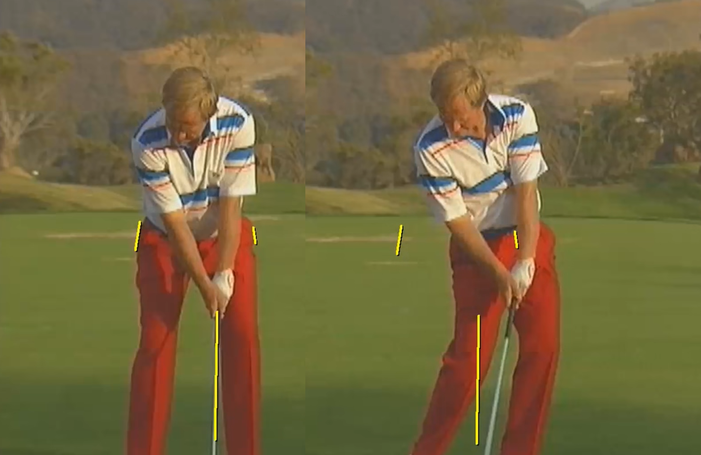
Let's take another at a great player, Adam Scott. Here you can see his position with his hips and club shaft. There you can see him during impact, everything is forward. That allows him to hit the ball before hits the ground. Anytime the handle of his shaft is forward like that as you've hit the ball you're going to hit the ground more forward. All that movement and all that thrust produces a lot of pressure in the club shaft against the golf ball, and gives you good distance.
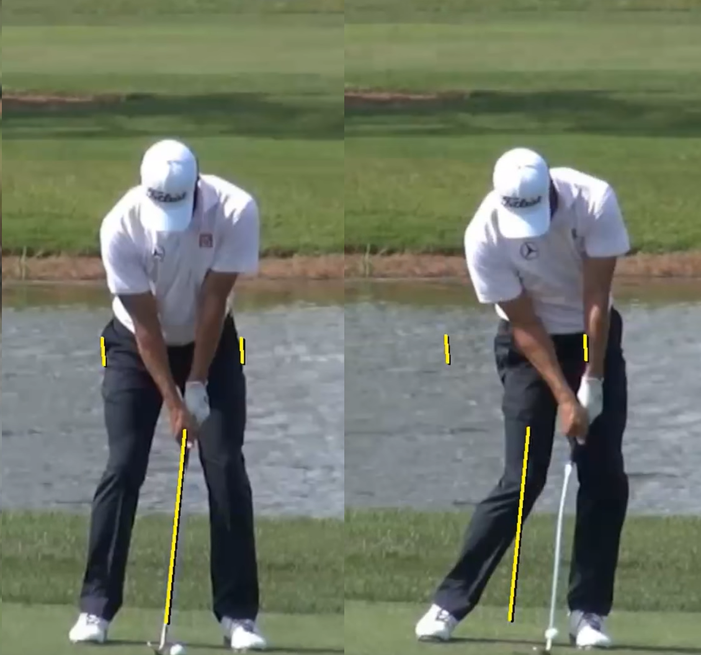
Now let's take a look at how you can do it. First I'll give you a couple of mental pitfalls I see a lot as well. Go somewhere you can practice your swing and put a little shaft or an alignment rod leaning slightly above the golf ball in front of you. Anything like that will do. That becomes your reference of your posture and position at address. You can use a short iron, like an eight, to start with small swings. All you need to do is feel around while keeping your head pretty still that you can drift pass the ball with your hips and get the handle past the ball before you hit it. It is not as all all difficult. What tends to get people in trouble, I promise you, is the attempt to hit at the ball and try to make solid contact. Another problem that rides with that last point it when players try to think too much of the clubhead. So, here's two keys for you: don't think 'clubhead', think 'club shaft'. That's always what you should be doing. Believe me. If you move the club shaft well then you will have success with your swing. If you hit at the ball with the clubhead you won't have success.
The other key, which I think is very helpful for people, is that it is your goal as the golfer not to hit the golf ball, rather to apply pressure to the golf ball. That's what you're really trying to do. You're trying to take that club face and put pressure on the ball so it compresses and goes. So if you think club shaft and you think pressure that will make your swing a lot easier. As I've said for a long time, the critical ingredient is to relax. Relax your mind and be a little bit playful. Don't prioritize results straight away. If you can't get the handle and your hips past that shaft then you're too mentally stuck in the wrong posture/position. Try a couple shots on a small scale while thinking about applying pressure to the ball.
As you practice build up to bigger swings, and clubs, and then dial it back down to smaller swings if you need to go back to it. It really couldn't be any easier. So, if you can "get the car in the garage" as Gary Player would say, and you can get the feeling of how to apply pressure to the ball, and move a little bit past the ball with your hips and handle, your golf swing is going to function extremely well. It's going to be awesome.
How To Square The Clubface At Impact Every Time

I want to talk to you in the section about how to square the clubface consistently. Obviously, squaring the clubface is extremely important if you are going to have accurate shots.
I want to touch on a practice strategy, but first let's talk a little bit about what not to do and what to try to do. I'm going to suggest that it is not a good idea, I'm going to use this as an example here, it is not a good idea to be to controlling with your hands or try to time everything with the small control muscles of your forearms and hands. Typically, that's the first instinct of someone who's trying to control the clubface.
I think it is better to talk about the release as more of a transfer of energy, more of a snap, and a release of the club that way. Try to think of a towel snapping straight. If you try to release that manually with your hands you're not going to have a very powerful or consistent release pattern.
So, number one: use your body to create potential energy in the club and then transfer the energy, much like cracking a whip or snapping a towel. That's where timing comes in, if you can do that consistently (time that release of energy), it will kind of have an automatic factor to the release of the club. Ok, that's number one.
Separately, even within that you still need to have some feel for squaring the clubface. Let's talk about a couple of things and then I'll show you a drill or two as we go. It is never a good idea to roll the face and stall the handle. What were trying to do is de-loft the left wrist and turn the clubface in a slightly outward fashion (that's what should be making the club close). There are two advantages to doing this. Number one is that it de-lofts the club a little bit and compresses the ball more. Number two is that it allows the left /forward wrist to stay firm and stay in front of the club believe me if this club is going forward and your leading wrist is scooping, you're not going to have any control of the clubface. So, we know it's a transfer of energy and we know as we transfer the left wrist it shouldn't cup and scoop. It should snap and de-loft.
How do we get the right recipe? A hard answer here, or maybe an answer you don't want to hear: you have to practice a little bit. Listen, in regards to a variable such as clubface you have to experience different things to get gain skill. I promise you you have to get on a bicycle to fine-tune balance and you might make a few mistakes as you go. So here's a drill I'm going to suggest.
Find yourself out and a practice golf course or range and put a couple balls on the ground without a tee. You'll see the flag out in the distance, take some little three quarter shots. Make some strikes and tell you're heading the ball solidly, and then over-do the wrist a little bit, and then don't do it so much. See how the ball moves and reacts to the differences. Once you get some skill and acquire some experience and understanding of wrist position you will up your game and up your game and feel much more comfortable with your swing. Be sure to keep the different variables in mind as you practice. Also remember to keep the energy going moving from your body, out to the club. You have to practice a little bit and play with some ideas, get the ball to move in some different ways, and then you will finally have an ownership over that skill. I hope that helped you.
Stop Hooking: Swing tips to hit the ball straight
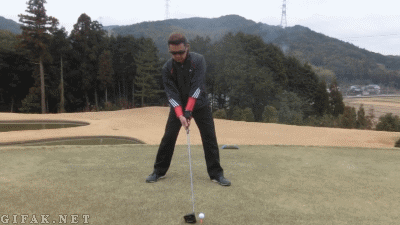
In this section I want to talk about how to stop hooking the golf ball. Learning how to hit the ball straight will definitely up your swing game. There's a lot of things that could go into this but there are really two primary focuses. That is, as you hit the ball, the direction the club is swinging (also known as the swing path). The second thing that goes into hooking a ball is the clubface angle relative to the swing.
Now, almost invariably, a (right-handed) player hooks the ball when they are swinging too far out to the right. On top of that, wherever they're swinging the clubface (at contact) is facing left of the swing. That's how you get the ball spinning off in crazy unforseen directions.
Today, let's talk a little bit more about swing path. You've had some great players of the years that had shut clubfaces who never had a problem hooking the ball. I'm not recommending a shot clubface, I'm saying let's focus on the most important element of this. That element is swing direction. If you tend to swing to the right, you should know that during your swing and as you're approaching contact with the ball, the handle of the golf club should already be tracking left. If you picture a slapshot in hockey then you can imagine that the handle stick is already facing to the left when the stick is making contact with the puck. The club head can still be coming slightly from the inside and the handle can be going left. Most people get into a real problem when both the handle and the club are going to the right. That's not going to work for you. Let me show you a drill that I think will be helpful for the player who hooks the ball.
The drill to get your swing path more down the target line and stop the hook is to take a short iron, such as a 9 iron, and make a little partial swing with two goals. The first goal is to finish the the club just about parallel to the ground, maybe a little bit higher (kind of around the middle of your body). The second goal, (and this is the key) is that at the end of your swing the club should be back in line with your heels, or the back of your body. That would indicate that the arch has gone around you a little bit more. One last thing, you're not allowed to fake it and kind of sew the club left. You want to feel like your arms are stable and the club is naturally finishing to the left of your body.
Remember, after your swing the club should be facing parallel to the ground and over by your left hip, around the back of your body. Doing that will really help stop the hook in your swing. I really hope that drill is helpful for you and that you can get a lot of success practicing it.

